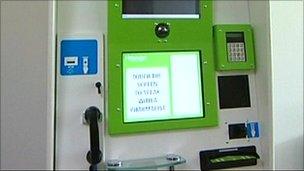Vending machines for prescription drugs on trial
- Published
How the different types of vending machines work
We are used to using vending machines for crisps, drinks and toiletries - but are we ready for them to give us our prescription drugs?
Each year, 886 million prescription drug items are dispensed in England and it is hoped this new technology can streamline the process.
There are questions though over if it is safe to break the patient-pharmacist link, if drugs stored in the machine will be safe from thieves and if people could fraudulently pick up the medicine meant for others.
Two different types of machines are being trialled with the aim of national roll-out across England.
The supermarket chain Sainsbury's is currently piloting a scheme in two of its West Sussex stores. After a year it will look at customer feedback, before deciding whether to extend to other stores. It is hoped the machines will speed up customer queuing times.
How it works

Roy Swift uses the machine for repeat prescriptions
Customers will use a unique ID or fingerprint as well as a Pin when putting in their prescription and again when they come back to collect the medicine, ensuring the drugs go to the correct person. While the patient waits, the pharmacist will prepare and place the drugs into the machine for collection.
Each machine can hold up to 450 packs of medicines.
Customer Roy Swift says: "I use the machine for my monthly prescriptions. The first time I used it, it was a little bit unfamiliar. But after I got used to it was very easy."
While the machines will be available only alongside the in-store pharmacy service, it is possible to conduct the whole process without face-to-face contact.
Repeat prescribing accounts for 80% of prescription items - the other items are treatments the patient has not used before and may be unfamiliar with.
A good idea?
Some GPS are concerned by this.
"Giving out medicine is not just box-shifting. The patient doesn't know if there are any questions that need to be asked or answered. The pharmacist hasn't met them so doesn't know either," says Dr Laurence Buckman, chairman of the British Medical Association GP Committee.
"The pharmacist will have the professional training to be able to spot when something is important. It can't be safe to hand over the prescription when you haven't met a pharmacist who knows whether that prescription is safe in combination with other things you are eating or other medicines you taking. A machine can't tell you this."
The National Pharmacy Association says: "Vending machines may complement but are no substitute for a full pharmacy service. The dispensing of medicines is a core service, but now only one of many services you find in pharmacies which include health checks, medical reviews and lifestyle interventions. For these, face-to-face advice and counselling is essential."
Videophone
Another type of automated drug dispensing machine will be trialled this winter in hospitals. It aims to help patients get their medicine out of hours or in remote areas.
This one has a videolink so the pharmacist can see and talk to the patient and vice-versa. The pharmacist can check the prescription as cameras in the machine photograph it and the image appears on the pharmacist's computer.
After the pharmacist has checked the prescription, conducted a full patient medical history, seen some ID and taken any payment, he or she can authorise the machine to dispense the drugs, which are stored inside.

Speaking to a pharmacist via video phone
The device costs around £50,000 and can stock up to 1,800 products. The manufacturers are confident thieves won't be able to break in, likening it to a cash machine.
Peter Ellis, executive managing director of PharmaTrust, the company supplying the machines in the UK, says: "It is made from plate steel, it weighs 2,000kg, it is protected by cameras both inside and outside. It would be hard to force any kind of entry."
Currently remote medicine dispensing is only legal in hospitals and healthcare centres. For any other location, a registered pharmacist needs to be physically present. However, the company hopes these rules may be relaxed in the future allowing them to be installed in High Streets, shopping malls and rural locations.
'Enabling' technology
Individual hospitals will decide it they want to take part in the trial. City Hospitals Sunderland NHS Foundation Trust is one of those involved.
Chief pharmacist David Miller says: "The technology provides the ability to maintain an off-site pharmacy service from the main dispensary, releasing the dispensary staff at quiet times in the morning and afternoon.
"There are many occasions where a full pharmacy service is currently uneconomic. This machine extends the reach of the pharmacist and provides increased access for the patient to a safe medication supply."
He says this new technology does not mean the end of the pharmacist. "In Sunderland, pharmacists spend over 90% of their time on direct patient care, rather then dispensary work, so it is a small but vital part of their role. This technology is an enabler, not a replacement for pharmacists.
"The measures of success will be, does it improve patient care, the ability to deliver medicines safely, effectively and economically and also whether hospital pharmacists welcome it as a friend rather than an imposition."
- Published3 August 2010